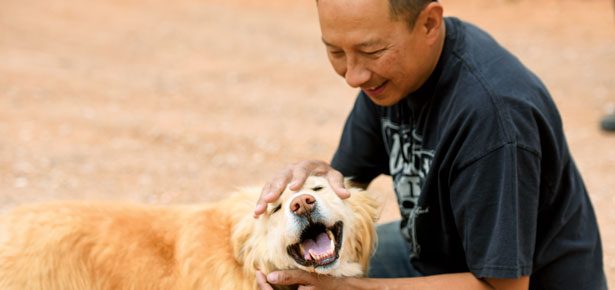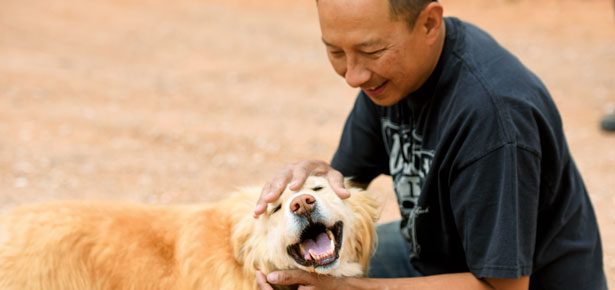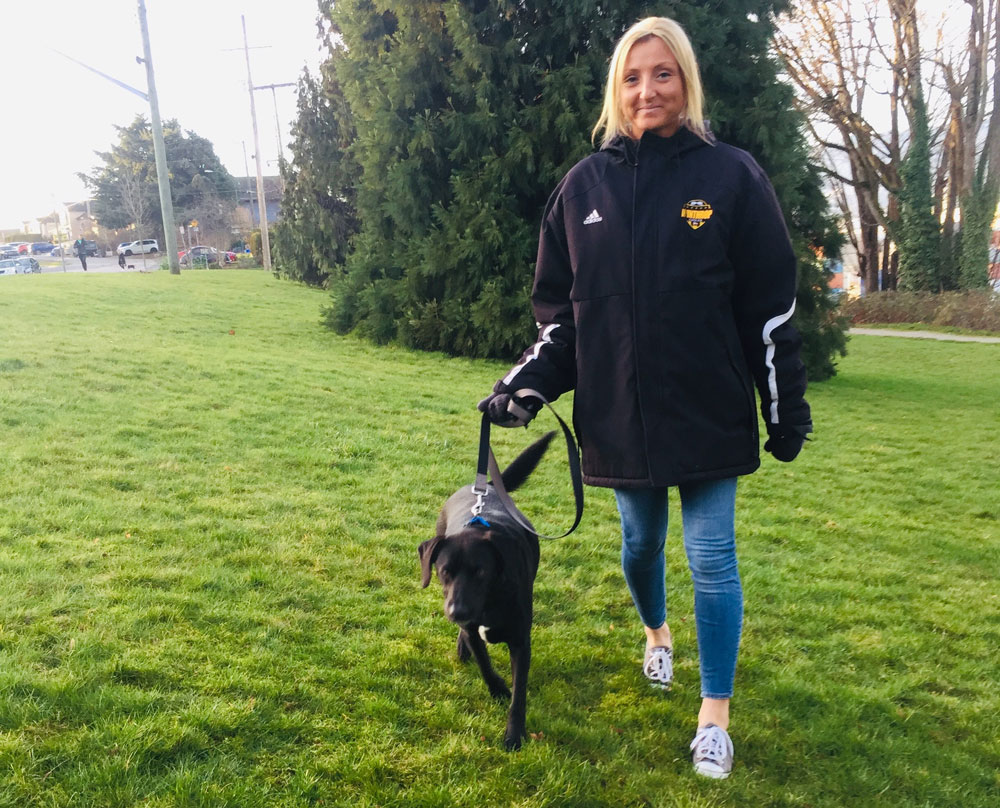

Jobs Working with Dogs!
Considering a career change? These four jobs allow you to turn your love of dogs into a livelihood.
As a dog lover, chances are you wanted a job working with dogs! You dreamt of a job like being a veterinarian when you grew up, but it’s a big commitment and life can get in the way. If you still dream of working with dogs, there are many opportunities to follow your passion in canine professions, whether you’re fresh out of college or thinking of a mid-life career change.
Here are some people who have done just that. They share with us how to get started, what it takes, the pros and cons, and how much you can get paid. Perhaps you too have a future job working with dogs! (Next issue we profile a dog trainer, animal behaviorist, dog massage specialist, and two pet shop owners.)
1. Dog Caregiver at an Animal Shelter
Shelter work is far from glamorous. This job involves cleaning and feeding, medicating and walking, and more chores behind-the-scenes. But the feel-good reward of helping animals? Priceless.
Steve Lee, age 52. Best Friends Animal Shelter, Kanab, Utah
“Watching the National Geographic Channel TV series DogTown (DogTown is the dog area at Best Friends Animal Sanctuary) about a decade ago, I never dreamed that I'd one day be working here—I wanted to work with animals but I only knew about my own pets. After working in IT for 20 years I decided the corporate world wasn’t for me, so in 2013 I quit my job and volunteered at Dogtown.
I was nervous and a bit intimidated. These people had worked in animal welfare for years, but they knew how much I wanted to make dogs’ lives better. By the third week, I applied for a permanent position as dog caregiver and the coordinator sent me all over Dogtown—I was being tested to work with all kinds of dogs. For instance, Indie was so shy she often feigned sleep. I read to her in a monotone voice and she was comfy with me. I was over the moon when Best Friends hired me. I moved here in my 16-foot trailer (now upgraded to 20-foot with a big bed) with my Beagle, and I’ve been at the “Peaches and Daisy” buildings—two of several buildings that house various groups of dogs in Dogtown—ever since.
It was a difficult learning curve and I made mistakes, but I soon learned how to focus on dog body language and the importance of reading their moods. And I garnered medical knowledge by default. It’s my job to make sure all my ‘kids’ get along with group living. For the first seven days, we put a dog in a run with another dog and if it doesn’t work we try another match. Sometimes a week or two later things deteriorate so I’m always observing their behaviour.”
Dog Caregiver: The Rundown
Pros: I love working with a creative group that always thinks outside the box. I love the breakthroughs with difficult dogs—when it works out, these kids give you everything in return. There’s always a new challenge where you have to change gears and look at things in another light. So rewarding.
Cons: Dog bites happen, but I’ve only had one bad bite from Dwayne. Some of my kids have terminal health issues. Bo had a big cancerous lump and we knew his time was limited. Little Jersey, a Katrina survivor, made it to 12 years old and she died in my arms. I have an emotional investment with all my kids so I’ve dealt with disappointments. The saddest thing is when a dog is adopted, but it doesn’t work out and they come back, but we just keep working to find them a home that will be a better fit.
Helpful traits: Because of my technology background I enjoy problem solving. You need patience and compassion for the job. You will get in good shape, walking and standing all day. As well, we work in snow and heat—I’m happy in any kind of weather.
Estimated Salary: HR said this is confidential information.
2. Dog Walker and Sitter
Dog walkers and sitters are increasingly in demand. Conscientious owners want their fur babies walked when they’re at work and not everyone can travel with their pets.
Amanda Negri, age 32. Must Love Dogs Daycare, Vancouver, BC. (mustlovedogsdogcare.ca)
“Last May I posted my profile on Rover.com, an app that makes it easy to advertise although they take a cut in exchange. At first it was a way to make extra income so I didn’t put in much effort: walking maybe two dogs a day wasn’t going to pay the rent. Two weeks into it, I realized this could be a part-time job so I uploaded some testimonials and more dog-walking photos. I also took a canine first-aid course, which gives owners more peace of mind. And another expense is liability insurance with Profur. That’s about it!
Combined with word-of-mouth, repeat customers, and requests pouring in from Rover.com, dogs are my full-time job. Now I walk about six hours a day with eight to ten dogs and usually housesit a dog every few weeks, which can be anywhere from two days to two weeks. I never considered making much money dogsitting (staying at their home as I am not allowed pets in my condo) but it’s really working out. I’ve never been happier in my career—and never thought I could make a living hanging with dogs all day.”
Dog Walker: The Rundown
Pros: So much joy seeing my regulars—we usually bond after a few walks. I love being active and getting involved with the dog community. I’m my own boss and can choose my hours to some extent, although most people want their dogs walked mid-day. Many walkers take several dogs at a time but I prefer one-on-one care.
Cons: Not having a steady income. I lost a few clients because people move and it’s not viable to drive far away for a walk. However, there’s no shortage of new clients and I have to turn away some people, so it can be a stressful schedule, especially when I am maxed out. As well, I rely on public transit and traffic can be an issue. And I think about what happens if an animal gets sick on my watch.
Helpful traits: You need patience, especially with puppies. Resilience and confidence. You need to be in good shape and love the outdoors. I appreciate all weather and don’t even mind when it pours, which happens often in Vancouver.
Estimated Salary: Anywhere from $500 to $1,000 per week, working full-time.
» Interested in Becoming a Pet Sitter?
Beth Stultz-Hairston with Pet Sitters International (PSI) advises to do plenty of research first.
Depending upon where you live, a business license might be required and be aware of any special regulations such as inspections if boarding in your home.
Insurance is vital to protect both your clients and your business.
Take an inventory of your current pet-care knowledge and experience. While loving animals is a pre-requisite, other skills are needed. Like Amanda, consider a canine first-aid course.
Training workshops, online classes, and even volunteer opportunities (such as at your local animal shelter) provide hands-on training in specific pet-care areas. Organizations such as Pet Sitters International can also provide access to training resources.
Be prepared to take care of the business aspects—insurance, accounting, legal fees when applicable, customer service, etc.
According to PSI, a pet sitter’s average gross revenue in 2017 was $75,658 US and $61,208.51 CAN.
3. Veterinarian Technician
Vet techs assist vets in diagnosing and treating animals in private clinics, animal hospitals, and more. They are often on the front line, evaluating an animal's condition, dressing wounds, checking vital statistics, and administering medication. Depending on the facility, they may supervise veterinary assistants.
Cassie Zydek, age 24. Companion Animal Specialty & Animal Hospital, Genoa City, Wisconsin
“Growing up I wanted to be a veterinarian but like so many animal lovers with that dream, it was too expensive and too competitive. I went to university for two years unsure of what I wanted to do, except I knew I wanted to work with animals. A nearby community college started a vet tech program and I was the last person to be accepted—my lucky break. But you must really want this career in order to be successful: the next two-and-a-half years were challenging. It requires a lot of studying, similar to nursing except that nurses learn about one species whereas we have to be familiar with a lot of species, from horses to hamsters. But dogs have always been my passion. With the exception of surgery, diagnosis, and prescribing medications, we do just about everything a veterinarian does.
Getting a job after graduating was easy. I first interned at four different vet hospitals, one of which hired me and I’ve been there ever since. It’s an emergency and specialty clinic and I work in ER, the first line of defense. Besides the obvious position at a clinic or hospital, many people don’t realize that there are so many other options. You can work at a zoo or aquarium, a state park or wildlife rehab, in a lab setting, or the Humane Society.”
Vet Tech: The Rundown
Pros: You get to be with animals and everyone I work with shares the same passion. It’s rewarding to see animals healed under our watch. And I have a secure job.
Cons: I’m not in it for the money and human nurses make lots more than vet techs. It’s hard work and often exhausting. Compassion fatigue happens and we can get burned out fast when dealing with sad situations. Some dog owners get mad at us; sometimes they can’t afford treatment; sometimes we have to tell them bad news.
Helpful traits: Being a team member, a people-person, and willing to try new things. Being compassionate is key, as well as outgoing and tough—you must be able to roll with the punches.
Estimated salary: Because there are so many opportunities in this field, that’s hard to nail down, but $40K average.
4. Dog Groomer
Dog groomers have the option of joining an existing company, somewhat like a hairstylist rents a chair, or starting their own business. Either way, you get to be a hairstylist for dogs!
Shelly Liboiron, age 45. Shelly's Little Dog Grooming, Regina, SK
“I worked in a warehouse for many years and that ended with knee surgery. I was able to get financial help through a workers’ program that helps find another career and when a dog grooming course was offered, I signed up. But not before I talked to other groomers to be certain this was the right choice.
The four-month course costs about $7,000 at a huge grooming salon. I liked it right away and worked there for a year but it was too fast-paced for me so I decided to open a home grooming salon and specialize in the little ones. Business was very slow at first and I was worried. An initial layout of more than $5,000 covered my business license, liability insurance, equipment, and knife sharpening. On top of that I bought a grooming table and bathtub, and I want to renovate another room.
I couldn’t put a sign outside my door to advertise but did some social media and lots of legwork. Walking my little Yorkie (she was also my calling card), I handed out business cards to anyone with a little dog. I dropped off my cards at vet clinics and pet stores and slowly built up my clientele, but it took at least 18 months. Sometimes I only had a few grooms a week, but I persevered. Now I groom three clients per day and I don’t want to do more. In the salon I felt rushed; here I get to know my clients and their people.”
Dog Groomer: The Rundown
Pros: I get to work with animals all day at home and have personal contact with my clients. It is satisfying to own my own business with little overhead working at home.
Cons: It’s frustrating when a client is late or a no-show. Some clients are severely matted so I put them on a program but some owners don’t follow up. I see that as abuse. I’ve been peed and pooed on and bitten a few times. Even though I have a regular clientele, it doesn’t guarantee financial security. And there’s a lot of dog hair in the house.
Helpful traits: Being patient and calm. Dogs sense stress.
Estimated salary: $28K, but lots of opportunity to make more.
What is your dream job working with dogs?
Join the newsletter and never miss out on dog content again!
"*" indicates required fields
By clicking the arrow, you agree to our web Terms of Use and Privacy & Cookie Policy. Easy unsubscribe links are provided in every email.



